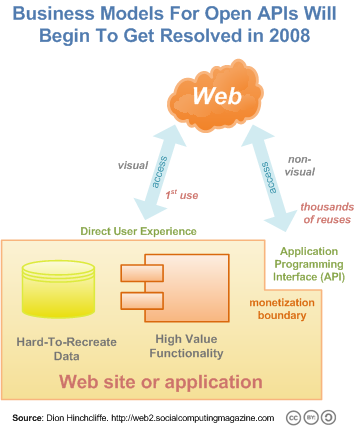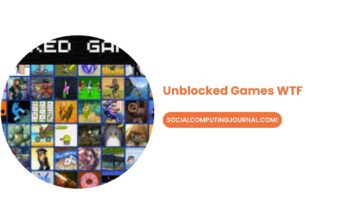It’s the first work day of the new year and I thought I’d take some time to offer up my predictions for what will happen on the leading edge of the Internet this year. 2007 saw Web 2.0 — defined here as the pervasive two-way Web used for social media, mashups, user-powered Web applications, and social networking — go far more mainstream than it had in 2006. Web 2.0 poster children like MySpace, Facebook, and YouTube pushed their way into the top 10 Web sites globally and stayed there for virtually all of 2007. Fresh, new Internet startups were created by the hundreds (even thousands, if you count the innumerable garage and bedroom attempts) last year and that trend isn’t going to stop any time soon and the reason is fairly obvious: The Web is simply the best place to create an incredibly scalable business for the least possible investment and effort.
However, that’s not to say that it’s easy to be successful online. It’s not, and the history of the Internet startup arena is littered with failures large and small, and many — even most — startups will inevitably succumb if they don’t provide a fairly compelling offering to the users of the Web. But fortunately for those that get the right mix of capabilities and user engagement in their online products, the upside can be nearly limitless. This fundamental fact helped drive the whole conception of Web 2.0: A new set of models and patterns creating Web sites and applications that looked at the best practices that actually worked from the success stories of the early Web. My point here is that the Web itself is in a state of perpetual evolution and we are all still learning a great deal all the time about what works and what doesn’t and the industry tries innovative new ideas all the time. In this way, 2008 will continue to be a fascinating year as we see what history’s largest ever business laboratory and incubator will turn out for us.
We are however assuredly seeing the maturation of the Web 2.0 industry, with many of the less successful online product plays falling by the wayside from first and second Web 2.0 wave as infamously tracked by Michael Arrington’s Web 2.0 Deadpool, with only a few meteoric stars rising to the top. The good news: That doesn’t mean there won’t be many exciting and innovative new things happening online this year, if you only know where to look.
Here’s my take on what we will see happen in 2008 in the Web 2.0 arena:
Web 2.0 Predictions for 2008

- Open APIs finally go beyond free as successful business models emerge. Sites like Twitter are finding that their APIs get ten times the use of the site itself (Web 2.0 principle: A platform beats an application every time), but monetizing them is a challenge for all but a few major player such as Amazon. While you can charge for each transaction across the API boundary, that isn’t appropriate for many types of API uses. Some have speculated that Twitter’s API usage is making them the middle-man, like the cable companies are with broadband, but with no reasonable way to charge for API usage that typical users would accept. Companies will continue to experiment with techniques such as injecting ads in the API data to requiring a small yearly fee to open an API for an individual user so they can use apps built for it. However, at least one major new API monetization model will emerge in 2008 that will prove to have long term legs. My bet: The costs will increasingly be bundled into a Web 2.0 application’s subscription fee or other business model, even if they use an API of the user’s preference, such as Amazon’s S3. This would require billing support from API vendors to chargeback for excessive use by a customer but it would work.
- Rich Internet Application (RIA) platforms such as Adobe AIR and Microsoft’s Silverlight get major traction as the development of non-trivial Web applications in Ajax remains difficult and time-consuming. While Ajax is made from 100% open Web standards, it was never explicitly designed for the job of creating rich user experiences and it’s proven tough going for many companies trying to create next generation Web experiences in Ajax. Adobe and Microsoft have been making enormous investments in browser plug-ins and supporting development tools that will change the way the Web will look in 2008 and beyond. These two platforms will be huge successes this year, despite the many challenges that RIA platforms face such as supporting page view-based business models, analytics, accessibility, network effects, link structure, search engine optimzation (SEO) and more.
- Google’s product strategy begins to coalesce into a mostly coherent picture, though a few big pieces won’t fit into the puzzle. While appearing to overextend itself into everything from online office application, mobile phone platforms, energy, and health, some of it will begin to make sense as the missing pieces begin to emerge next year. Look for a strategy that combines a long-term vision to integrate enormous user reach (online, mobile, SNS) as well as function (software apps and utility capabilities such as search and location) and business (advertising) into an interlocking platform play of a scope and breadth that will, pound for pound, out maneuver the vast majority of their competition. Disclaimer: I am a Google shareholder.
- The Web 2.0 industry consolidates as it begins to mature. This has been covered extensively on Mashable and John Battelle’s 2008 prediction list so I don’t need to repeat their outlooks, which I generally agree with. Most startups, as in any generation, will fall by the wayside and a few major success stories will emerge. Mergers and acquisitions will ensue. The next generation will begin, and so on. The reality is that most new Web apps are still mostly Web 1.0. We still have a long way to go before Web 2.0 design patterns are standard fare but Web 3.0 (whatever that turns out to be) will come upon us while that’s still happening. 2008 will see a lot of old Web 2.0 faces be acquired or leave the scene entirely.
- End-user mashups will be a reality but adoption will be slow for most of the year as users take time coming to grips with the possibilities and mindset. A little while back I wrote a detailed list of reasons why end-user mashups wouldn’t happen in a big way in 2007. Since then, it looks like only a couple of those reasons will be addressed in 2008. Despite this, we’ll see mashup platforms being rolled out by IT departments and high-functioning businesses as a significantly better and cheaper way to solve many problems by remixing the immense pool of content and functionality on the Web and in our organizations. The average user will need time for this potential to be appreciated and understood but we’ll see the first significant creation of end-user assembled Web applications in 2008.
- The Web widget format wars will ensue as Google Gadgets/OpenSocial takes on just about everyone else. No one will win yet. 2007 was the year of the Do-It-Yourself era when it comes to users creating their own experiences out of the Web, often by just pulling off the parts of a Web site they liked and sharing it with others in their blogs and user profiles. To embrace this demand, almost all major Web sites currently offer their sites in modular chunks known as widgets, or if you’re Google or Microsoft, gadgets that their users can distribute. However, like many aspects of Web 2.0, Web widgets are an emergent phenomenon with no large company or standards organization having created it up front with lots of engineering and funding. As a result, there are many different ways to design and offer a Web widget with Google taking the clear lead at the moment with well over 30,000 different Gadgets currently being offered. Throw in SNS widget/app platforms such as Facebook applications and OpenSocial and you have a recipe for fragmentation and an increasing to do list for Web sites which want to participate in what is a growing and often captive ecosystem of users controlled by each format’s backer. No consensus will be reached by the Web industry in 2008 but many solutions will be proposed, such as the W3C’s Widget spec.
- Page view “inventories” for online advertising continues to fall short of demand, even if an economic downturn takes place. The well regarded McKinsey & Company predicted last year that advertising will actually have fairly significant growth challenges for the next five years from high demand and lack of maturity in the management of online advertising through traditional outlets. My personal take: I’ve seen enough pent-up demand that I don’t think even an economic downtown will noticeable affect the fortunes of online adveritising for the foreseeable future.
- Web-based Software as a service (SaaS), aka Office 2.0, continues to encounter serious challenges but grows at a record pace anyway. Offline access to applications and data remains one of the biggest challenges to true Web-based software, but Google Gears and offerings from firms like Etelos are offering more and more options to make Web apps work offline (albeit with reductions in functionality). Other challenges include the cumulative drag of paying a periodic subscription fee for access to software as well security and overall capability. Despite this, positive aspects of SaaS will continue to prevail and 2008 is looking to be the biggest SaaS year yet.
- A wave of new killer mobile Web applications (and their startups) appear, spurred by the iPhone Software Development Kit (SDK) and ever more untethered workers. Twitter was likely just the first in an era of fundamentally network-oriented applications with communications and collaboration at their design core. The release of the iPhone last year proved that Web apps could be nearly as functional and pleasing as desktop apps. The coming iPhone SDK, which will let anyone build iPhone software legally, will help usher in a new era of useful new consumer and business mobile applications, many which will sport Web 2.0 capabilities or even be fundamentally Web 2.0 based, such as route capturing software and automatic traffic tracking, particularly as more mobile devices add GPS capability in 2008.
- The first Android-powered phones will fail to impress and a decent, though not spectacular, iPhone upgrade keeps Apple ahead of the industry. Google’s widely covered Android platform will experience the usual beta/1.0 issues, particularly since one company doesn’t have control over the entire product development process of Android phones. Expect a somewhat rocky second half of ’08 for Android while Apple maintains its market lead with what is still the most Web-friendly communications device yet created by releasing a solid upgrade of the iPhone this year, perhaps even twice. Mobile Web 2.0 apps will continue to get very popular in 2008.
- Social media begins to grow up, leading to the first significant onset of Web 2.0 versions of talent agents, production companies, and other supply/demand enablers. Blogs and other forms of social media such as backyard produced YouTube videos let anyone reach out to the entire audience of the Web at the cost of nothing more than a little bit of their time. Despite the hugely democratizing effect this is having in the media world, the new online stars of the Web 2.0 still need professional help to maximize their opportunities and potential. While this has been going on for a while with media companies cultivating paid bloggers and other forms of leveraging social media, expect that the social media phenomenon will being to create its own cottage industry of agents that can help the talented reach the Web mot effectively, for a cut of the action of course. On the other side, production companies will form to give rising stars the resources they need to succeed. We’ll see a spate of new companies forming around this growing need in 2008, as traditional companies in this space continue to struggle with the medium.
- Leading social networking sites MySpace and Facebook continue to maintain their traffic but struggle to ignite significant revenue growth. Facebook’s widely covered struggles late last year with the business model of its Beacon product is somewhat indicative of the entire Web 2.0 era: Incredible levels of participation with serious challenges to leveraging said participation due to privacy, governance, ownership, copyright, and other issues. Make no mistake, however, these issues will be solved given the massive global stake in a successful outcome but it’ll take at least through 2008 to do it.
- The Web moves into the living room as sites like Hulu and others make it practical and rewarding to participate on the Web using a large screen for entertainment. Digital convergence in the main room of our homes has been in progress for a half-decade or more. I’m a little reluctant to call it but I have definitely noticed a sharp uptick in the people I know starting to use the Web on the big screen. New Web apps are emerging to make it popular and mainstream, and in 2008, will see the first big major uptake of Web usage — with rich media apps in particular — in our living rooms.
- The first generation of pure Web 2.0 auteurs emerge, creating social media and user-centric online experiences that are highly imaginative and popular, but difficult to access for the non-digitally literate. The first generation of users whose most formative years were primarily spent in the Web 2.0 era are beginning to reach the age where they will become significant creative forces in their own right. As the Web has become easy enough for semi-technical people to create nearly any experience they wish, expect that a generation of youth who consider the Web as natural a medium as the air they breath will begin to generate not just content but the next aspects of the Web itself. While we continue to hold up movie directors, authors, TV production firms, and commercial Internet companies as the creators of most of the common large-scale group experiences we have, expect that Web 2.0 will impose its egalitarian influences here as well. I predict we’ll see an initial handful of Web 2.0 auteurs emerge that will offer large-scale Web-based “experiences” that will not only redefine the notion of the Web site itself but will be widely used as well. I also expect that many of them will come from developing nations or from other unexpected locations and less from the United States and Europe.
- Update: Ownership of data contributed to Web 2.0 sites becomes a growing public relations issue, though the average user won’t care much this year. I added this because the growing brouhaha about Robert Scoble’s blocked Facebook account reminded me that we’ll continue see many sites attempt to control the data they receive from users in a very Web 1.0 way. This is somewhat surprising given it’s 2008 and we’ve learned these lessons in the industry the hard way already. However, it’s entirely correct that Web sites should maintain control over their valuable and hard to recreate data. A good example is how YouTube jealously protects its videos and doesn’t let you download them, only view them on the site or through the badge. Yet the often contrarian nature of the Web sometimes requires the opposite of an action to get the desired effect. In this case, it turns out that the more control you give up, the more value you tend to get back. Sites that lock users in, prevent them from having the experiences they want, and exert excessive and unfair control, will lose in the end. See DataPortability.org and the GraphSync project, which aims to enable the open movement of a user’s social graph, as examples of where all this is headed.
Update: TechCrunch covers JP Morgan’s bullish predictions for the Web business in 2008.
Where do you think the Web will go in 2008? Please leave your take in comments below.



